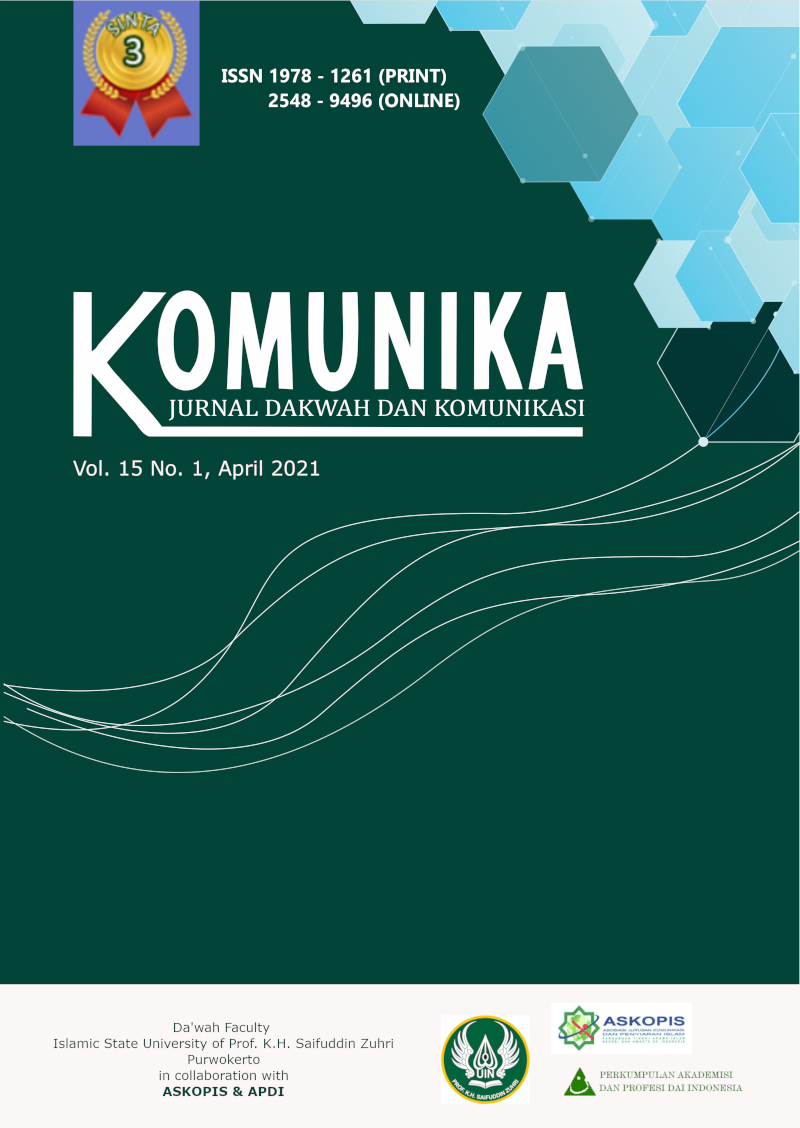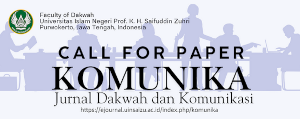The Da'wah Messages as the Spiritual Marketing Approach of Islamic Fashion E-Commerce at HIJUP.COM
DOI:
https://doi.org/10.24090/komunika.v15i1.4696Keywords:
Spiritual marketing, Islamic fashion, Da’wah messageAbstract
Indonesian Muslim consumers are looking for functional and emotional benefits in products and seeking spiritual blessings. This trend is a challenge for Islamic fashion e-commerce in promoting its products. This study uses a qualitative approach with the type of single case study research methods. The subject of this research is Islamic fashion e-commerce HIJUP.com. Researchers selected informants in the study using purposive sampling and snowball sampling techniques. Researchers used two analysis methods in case of breakdowns: an analysis based on theoretical propositions and developing case descriptions. The study results show that in Islamic fashion e-commerce, HIJUP.com contains the contents of da'wah messages, precisely, Look Good, Feel Good, Do Good. The da'wah message includes a philosophy that leads to obedience to Allah SWT concept. The message structure uses conclusion drawing and order of presentation. The message display in HIJUP.com is high-tech but straightforward techniques. The message format is unique, with interests in story or narrative and visual elements. The source of the message uses brand ambassadors, influencer marketing, and also buzzers. The study concludes that the da'wah message conveyed by Islamic fashion e-commerce includes aqidah, sharia, and morals that focus on obedience to Allah SWT, not in the preaching style while inspiring to empower Muslim women.Downloads
Download data is not yet available.
References
Adiba, E. M. (2019). Consumer Purchasing Behavior of Halal Cosmetics: A Study on Generations X and Y. Journal of Islamic Monetary Economics and Finance, 5(1), 169–192.
Ahmad, F. I. (2011). Dakwah Online: Asyiknya Meraup Pahala Di Dunia Maya. Mizan.
Ananda, I. P. (2017). World Muslimah Sebagai Budaya Populer Dalam Bingkai Media Online Islam. Al-Balagh Jurnal Dakwah Dan Komunikasi, 2(2), 165–190.
Appel, G., Grewal, L., & Hadi, R. (2019). The Future of Social Media in Marketing. Journal of the Academy of Marketing Science, 79–95.
Aribawa, D. (2016). E-commerce Strategic Business Environment Analysis in Indonesia. International Journal of Economics and Financial Issues, 6(S6), 130–134.
Armiah. (2015). Strategi Dakwah Lewat Iklan Produk Halal di Media Alhadharah. Jurnal Ilmu Dakwah, 14(27), 1–13.
Boonchai, H. (2018). Effect of Message Variation and Communication Tools Choices on Consumer Response. Journal of Consumer Research, 20(1), 42–56.
Budiantoro, W. (2017). Dakwah Di Era Digital. Komunika: Jurnal Dakwah Dan Komunikasi, 11(2), 263–281. https://doi.org/10.24090/KOMUNIKA.V11I2.1369
Dinillah, U., & Kurnia, A. (2019). Media Sosial Instagram Sebagai Media Dakwah. Kaganga Journal of Communication Science, 1(1), 54–67.
Handes. (2019). Creative Planning Dan Strategi Pengembangan Pesan. Al-Hikmah Jurnal Dakwah, 13(1), 1–33.
Hassan, F. H., Kasi, P. M., Shaharuddin, N. A., & Kechil, M. F. A. (2019). Islamic and Modest Fashion Lifestyle. Journal of Islamic Management Science, 79–88.
Juhari. (2020). Tantangan dan Arah Dakwah Di Tengah Ancaman Pandemi Covid-19. Jurnal Peurawi Media Kajian Komunikasi Islam, 3(2), 46–60.
Khoriyah, N. (2011). Dakwah dan Dimensi Akulturasi Budaya. Komunika: Jurnal Dakwah Dan Komunikasi, 5(1), 11–27. https://doi.org/10.24090/KOMUNIKA.V5I1.767
Kumar, Vinod, et al. (2014). Marketing through spirituality: A case of Patanjali Yogpeeth. Procedia- Social and Behavioral Sciences, 133, 481–490. https://doi.org/10.1016/j.sbspro.2014.04.215
Maftuchah, F. (2015). Dialog dan Toleransi (Sebuah Alternatif Dakwah Di Tengah Pluralitas Agama). Komunika: Jurnal Dakwah Dan Komunikasi, 9(1), 58–66. https://doi.org/10.24090/KOMUNIKA.V9I1.830
Minan, I. (2016). Relasi Media Massa dan Dakwah Kontemporer. Al-Balagh Jurnal Dakwah Dan Komunikasi, 1(2), 197–214.
Naeem, B., & Naz, M. B. U. (2013). Integrated Marketing Communication: A Review Paper. Interdisciplinary Journal of Contemporary Research in Business, 5(5), 124–133.
Rakhmat, J. (2020). Psikologi Komunikasi Edisi Revisi. Simbiosa Rekatama Media.
Rochman, K. L. (2015). Mengurai Kebingungan (Refleksi Terhadap Kesemrawutan Konsep Dakwah Islam Di Indonesia). Komunika: Jurnal Dakwah Dan Komunikasi, 9(2), 218–242. https://doi.org/10.24090/KOMUNIKA.V9I2.851
Saliyo. (2020). Perspektif Psikologi Islam dalam Dakwah Ramadhan di Televisi. Komunika: Jurnal Dakwah Dan Komunikasi, 14(2), 183–198.
Sigit, M. (2018). Marketing Syariah sebagai Jiwa Bisnis. Conference on Islamic Management, Accounting, and Economics (CIMAE) Proceeding Volume 1, 146–152.
Somdech, R., Sriyakulb, T., & Jermsittiparsert, K. (2019). The Era of e-Commerce & Online Marketing: Risks Associated with Online Shopping. International Journal of Innovation, Creativity, and Change, 8(8), 201–221.
Sugiyono. (2007). Metode Penelitian Kuantitatif, Kualitatif dan R&D. Alfabeta.
Sula, M., & Kertajaya, H. (2005). Syariah Marketing. Mizan.
Tafesse, W., & Wien, A. (2017). Using Message Strategy to Drive Consumer Behavioral Engagement on Social Media. Journal of Consumer Marketing Forthcoming, 3.
Watono, A. A., & Watono, M. C. (2011). IMC Integrated Marketing Communication That Sells. Gramedia Pustaka Utama.
Yin, R. K. (2013). Studi Kasus Desain dan Metode Edisi Revisi. PT. Raja Grafindo Persada.
Yuswohady, Herdiansyah, I., Fatahillah, F., & Ali, H. (2017). Gen M #Generation Muslim “Islam Itu Keren.†Mizan Media Utama.
Company Profile HIJUP.COM (2019). www. https://www.hijup.com/en/pages/about
Instagram HIJUP.COM (2020).www.instagram.com/@hijup
Ahmad, F. I. (2011). Dakwah Online: Asyiknya Meraup Pahala Di Dunia Maya. Mizan.
Ananda, I. P. (2017). World Muslimah Sebagai Budaya Populer Dalam Bingkai Media Online Islam. Al-Balagh Jurnal Dakwah Dan Komunikasi, 2(2), 165–190.
Appel, G., Grewal, L., & Hadi, R. (2019). The Future of Social Media in Marketing. Journal of the Academy of Marketing Science, 79–95.
Aribawa, D. (2016). E-commerce Strategic Business Environment Analysis in Indonesia. International Journal of Economics and Financial Issues, 6(S6), 130–134.
Armiah. (2015). Strategi Dakwah Lewat Iklan Produk Halal di Media Alhadharah. Jurnal Ilmu Dakwah, 14(27), 1–13.
Boonchai, H. (2018). Effect of Message Variation and Communication Tools Choices on Consumer Response. Journal of Consumer Research, 20(1), 42–56.
Budiantoro, W. (2017). Dakwah Di Era Digital. Komunika: Jurnal Dakwah Dan Komunikasi, 11(2), 263–281. https://doi.org/10.24090/KOMUNIKA.V11I2.1369
Dinillah, U., & Kurnia, A. (2019). Media Sosial Instagram Sebagai Media Dakwah. Kaganga Journal of Communication Science, 1(1), 54–67.
Handes. (2019). Creative Planning Dan Strategi Pengembangan Pesan. Al-Hikmah Jurnal Dakwah, 13(1), 1–33.
Hassan, F. H., Kasi, P. M., Shaharuddin, N. A., & Kechil, M. F. A. (2019). Islamic and Modest Fashion Lifestyle. Journal of Islamic Management Science, 79–88.
Juhari. (2020). Tantangan dan Arah Dakwah Di Tengah Ancaman Pandemi Covid-19. Jurnal Peurawi Media Kajian Komunikasi Islam, 3(2), 46–60.
Khoriyah, N. (2011). Dakwah dan Dimensi Akulturasi Budaya. Komunika: Jurnal Dakwah Dan Komunikasi, 5(1), 11–27. https://doi.org/10.24090/KOMUNIKA.V5I1.767
Kumar, Vinod, et al. (2014). Marketing through spirituality: A case of Patanjali Yogpeeth. Procedia- Social and Behavioral Sciences, 133, 481–490. https://doi.org/10.1016/j.sbspro.2014.04.215
Maftuchah, F. (2015). Dialog dan Toleransi (Sebuah Alternatif Dakwah Di Tengah Pluralitas Agama). Komunika: Jurnal Dakwah Dan Komunikasi, 9(1), 58–66. https://doi.org/10.24090/KOMUNIKA.V9I1.830
Minan, I. (2016). Relasi Media Massa dan Dakwah Kontemporer. Al-Balagh Jurnal Dakwah Dan Komunikasi, 1(2), 197–214.
Naeem, B., & Naz, M. B. U. (2013). Integrated Marketing Communication: A Review Paper. Interdisciplinary Journal of Contemporary Research in Business, 5(5), 124–133.
Rakhmat, J. (2020). Psikologi Komunikasi Edisi Revisi. Simbiosa Rekatama Media.
Rochman, K. L. (2015). Mengurai Kebingungan (Refleksi Terhadap Kesemrawutan Konsep Dakwah Islam Di Indonesia). Komunika: Jurnal Dakwah Dan Komunikasi, 9(2), 218–242. https://doi.org/10.24090/KOMUNIKA.V9I2.851
Saliyo. (2020). Perspektif Psikologi Islam dalam Dakwah Ramadhan di Televisi. Komunika: Jurnal Dakwah Dan Komunikasi, 14(2), 183–198.
Sigit, M. (2018). Marketing Syariah sebagai Jiwa Bisnis. Conference on Islamic Management, Accounting, and Economics (CIMAE) Proceeding Volume 1, 146–152.
Somdech, R., Sriyakulb, T., & Jermsittiparsert, K. (2019). The Era of e-Commerce & Online Marketing: Risks Associated with Online Shopping. International Journal of Innovation, Creativity, and Change, 8(8), 201–221.
Sugiyono. (2007). Metode Penelitian Kuantitatif, Kualitatif dan R&D. Alfabeta.
Sula, M., & Kertajaya, H. (2005). Syariah Marketing. Mizan.
Tafesse, W., & Wien, A. (2017). Using Message Strategy to Drive Consumer Behavioral Engagement on Social Media. Journal of Consumer Marketing Forthcoming, 3.
Watono, A. A., & Watono, M. C. (2011). IMC Integrated Marketing Communication That Sells. Gramedia Pustaka Utama.
Yin, R. K. (2013). Studi Kasus Desain dan Metode Edisi Revisi. PT. Raja Grafindo Persada.
Yuswohady, Herdiansyah, I., Fatahillah, F., & Ali, H. (2017). Gen M #Generation Muslim “Islam Itu Keren.†Mizan Media Utama.
Company Profile HIJUP.COM (2019). www. https://www.hijup.com/en/pages/about
Instagram HIJUP.COM (2020).www.instagram.com/@hijup
Downloads
Published
2021-06-30
Issue
Section
Articles
License
Authors who publish with this journal agree to the following terms:
- Authors retain copyright and grant the journal right of first publication with the work simultaneously licensed under a Creative Commons Attribution-ShareAlike 4.0 International License that allows others to share the work with an acknowledgement of the work's authorship and initial publication in this journal.
- Authors are able to enter into separate, additional contractual arrangements for the non-exclusive distribution of the journal's published version of the work (e.g., post it to an institutional repository or publish it in a book), with an acknowledgement of its initial publication in this journal.
- Authors are permitted and encouraged to post their work online (e.g., in institutional repositories or on their website) prior to and during the submission process, as it can lead to productive exchanges, as well as earlier and greater citation of published work (See The Effect of Open Access).

























